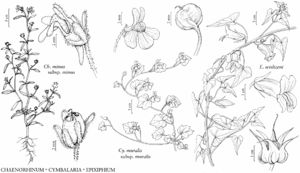Difference between revisions of "Epixiphium wislizeni"
Proc. Calif. Acad. Sci., ser. 4, 15: 380. 1926.
FNA>Volume Importer |
imported>Volume Importer |
||
| (5 intermediate revisions by 2 users not shown) | |||
| Line 10: | Line 10: | ||
|special_status={{Treatment/ID/Special_status | |special_status={{Treatment/ID/Special_status | ||
|code=F | |code=F | ||
| − | |label= | + | |label=Illustrated |
}} | }} | ||
| − | |basionyms={{Treatment/ID/ | + | |basionyms={{Treatment/ID/Basionym |
|name=Maurandya wislizeni | |name=Maurandya wislizeni | ||
| − | |authority=Engelmann ex A. Gray in W. H. Emory | + | |authority=Engelmann ex A. Gray |
| + | |rank=species | ||
| + | |publication_title=in W. H. Emory, Rep. U.S. Mex. Bound. | ||
| + | |publication_place=2(1): 111. 1859 | ||
}} | }} | ||
|synonyms={{Treatment/ID/Synonym | |synonyms={{Treatment/ID/Synonym | ||
|name=Asarina wislizeni | |name=Asarina wislizeni | ||
|authority=(Engelmann ex A. Gray) Pennell | |authority=(Engelmann ex A. Gray) Pennell | ||
| + | |rank=species | ||
}} | }} | ||
|hierarchy=Plantaginaceae;Epixiphium;Epixiphium wislizeni | |hierarchy=Plantaginaceae;Epixiphium;Epixiphium wislizeni | ||
| Line 43: | Line 47: | ||
-->{{#Taxon: | -->{{#Taxon: | ||
name=Epixiphium wislizeni | name=Epixiphium wislizeni | ||
| − | |||
|authority=(Engelmann ex A. Gray) Munz | |authority=(Engelmann ex A. Gray) Munz | ||
|rank=species | |rank=species | ||
| Line 57: | Line 60: | ||
|publication title=Proc. Calif. Acad. Sci., ser. | |publication title=Proc. Calif. Acad. Sci., ser. | ||
|publication year=1926 | |publication year=1926 | ||
| − | |special status= | + | |special status=Illustrated |
| − | |source xml=https:// | + | |source xml=https://bitbucket.org/aafc-mbb/fna-data-curation/src/2e0870ddd59836b60bcf96646a41e87ea5a5943a/coarse_grained_fna_xml/V17/V17_92.xml |
|genus=Epixiphium | |genus=Epixiphium | ||
|species=Epixiphium wislizeni | |species=Epixiphium wislizeni | ||
Latest revision as of 19:37, 5 November 2020
Annuals 30–120 cm, vines. Leaves: petiole 14–54 mm; blade hastate to broadly sagittate, 21–75 × 8–48 mm, surfaces glabrous. Pedicels ascending, 3–9 mm, thickened in fruit. Flowers: sepals 13–18 × 2–4 mm, basally keeled, membranous in flower, 20–32 × 8–12 mm, indurate in fruit; corolla tube 17–22 mm, glabrous or sparsely hairy, throat open, palate not inflated, abaxial plicae white spotted with blue or violet, lobes: abaxial reflexed, adaxial erect, equal, 7–12 mm; stamens included, filaments incurved, hairy at base, abaxial 11–13 mm, adaxial 13–15 mm, pollen sacs oblong; ovary glabrous, locules subequal; style included, 13–15 mm, indurate in fruit, stigma recurved. Capsules ovoid, compressed apically, 11–15 mm, indurate. Seeds 3–4 mm, surface tuberculate, circumalate. 2n = 24.
Phenology: Flowering Apr–Nov.
Habitat: Active and stabilized siliceous and gypseous dunes and sandy soils.
Elevation: 1100–2100 m.
Distribution
Ariz., Calif., N.Mex., Tex., Mexico (Chihuahua).
Discussion
Epixiphium wislizeni is easily identified in fruit and by its occurrence on unconsolidated, sandy soils. When vegetative or in flower, it resembles Maurandella antirrhiniflora. In Texas, E. wislizeni is known from the trans-Pecos region.
Selected References
None.
